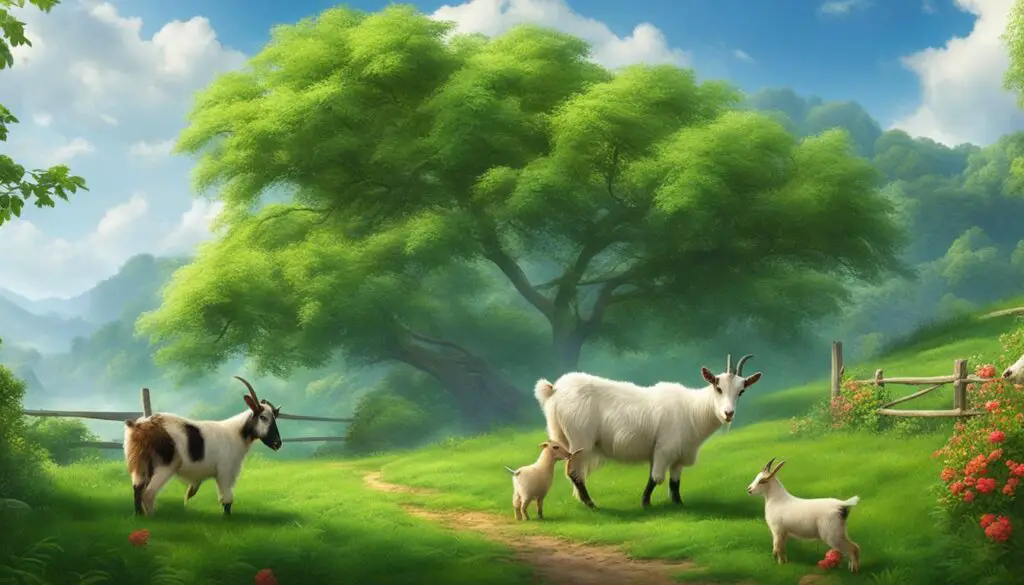If you are considering raising goats, one of the crucial factors to consider is the amount of land space they require. Proper land space ensures the well-being and happiness of your goats. In this article, we will explore the ideal land size for two goats, their grazing requirements, and other considerations for goat enclosures.
Goats are social animals and thrive when they have companionship. It is recommended to keep at least two goats together to provide company for each other. For two goats, a minimum of 500 square feet of space is needed to ensure their comfort and freedom to move around. This space should include the shelter, grazing area, and exercise space.
While goats don’t necessarily need a large pasture to graze in, having access to fresh forage, hay, and water on a daily basis is essential. Goats are browsers and enjoy a variety in their diet; however, if grass is their only source of nutrition, they will graze on it. Providing a pasture allows them to practice natural behaviors, such as foraging and exploring different types of foliage, which offers mental stimulation and a varied diet.
In addition to proper land space, it is crucial to have a secure fencing setup to keep the goats safe and prevent them from escaping. Goats are notorious escape artists, and a sturdy fence will help ensure their safety as well as the safety of neighboring properties. A good fencing setup will also protect your goats from predators.
Key Takeaways:
- Two goats require a minimum of 500 sq. ft of space, including shelter, grazing area, and exercise space.
- Goats are social animals and thrive in the company of other goats.
- While goats don’t require a pasture, it provides mental stimulation and a varied diet.
- A secure fencing setup is essential to keep the goats safe and prevent escapes.
- Proper land space and fencing ensure the well-being and happiness of your goats.
Do Goats Need a Pasture to Graze In?
When it comes to the dietary preferences of goats, they are browsers rather than grazers. This means that they prefer to eat a variety of foliage, including leaves, shrubs, and bushes, rather than just grass. However, if grass is their only source of nutrition, goats will reluctantly graze on it.
Having a pasture for goats to explore is beneficial for several reasons. Firstly, it provides them with mental stimulation, as they can roam and explore different areas. Secondly, a pasture allows goats to forage on a variety of plants, which adds diversity to their diet and contributes to their overall health.
While goats can certainly thrive in pastures, it is important to note that they can also be successfully kept in smaller areas as long as they are provided with sufficient hay and other feed sources. This is especially relevant in situations where pasture land is limited or not available.
However, regardless of whether goats have access to a pasture or not, it is essential to have a secure fencing setup in place. Goats are known to be escape artists, and they will try to find greener pastures if given the chance. By ensuring that the fencing is sturdy and properly maintained, you can prevent goats from wandering off and keep them safe within their designated area.
In summary, while goats don’t necessarily need a pasture to graze in, having one provides them with mental stimulation, variety in their diet, and the opportunity to forage on different types of plants. However, goats can also thrive in smaller areas if provided with sufficient hay and other feed sources. Regardless of the setup, a secure fencing system is crucial to keep goats safe and prevent them from wandering off.
Grazing vs. Browsing – A Comparison
| Grazing | Browsing | |
|---|---|---|
| Definition | Eating grass and other ground vegetation | Eating a variety of foliage, including leaves, shrubs, and bushes |
| Dietary Preference | Grass | Foliage |
| Behavior | Spends more time on the ground, actively seeking out grass to consume | Explores and roams in search of different plants to eat |
| Benefits | Provides quick and easy nutrition | Adds variety to the diet and offers mental stimulation |
As shown in the table above, grazing and browsing are distinct feeding behaviors that have different preferences and benefits. While grazing focuses on consuming grass as the primary food source, browsing allows goats to explore and enjoy a more varied diet consisting of different types of foliage.
Can Goats Co-Habitate with Other Animals?
Goats are social animals that can live harmoniously with a variety of other animals. They are known to co-habitate well with species such as sheep, llamas, horses, and cows. This peaceful coexistence can create a lively and diverse environment on a farm or in a rural setting.
When it comes to feathered friends, goats can also share their space with chickens, ducks, geese, and even ostriches. However, if goats are being milked, it’s important to keep them separate from fowl to avoid any potential contamination of the milk.
“Goats can co-habitate with a variety of animals but should not be kept with pigs.”
Pigs, being omnivores, may exhibit aggressive behavior towards goats or even pose a threat to their well-being by attempting to prey on them. Therefore, it is advisable to keep goats and pigs separated to ensure the safety and welfare of both species.
Overall, goats have the potential to be excellent companions for animals of various species, contributing to a diverse and dynamic farm ecosystem.

| Species | Potential Co-Habitation |
|---|---|
| Sheep | Yes |
| Llamas | Yes |
| Horses | Yes |
| Cows | Yes |
| Chickens | Yes |
| Ducks | Yes |
| Geese | Yes |
| Ostriches | Yes |
| Pigs | No |
Male and Female Goats – Can They Be Kept Together?
When it comes to keeping male and female goats together, there are a few considerations to keep in mind. Female goats, known as does, can be kept together without any issues. They generally get along well and form strong social bonds within the herd.
Castrated males, called wethers, can also be kept with does without any issues. Since they aren’t capable of breeding, there’s no risk of unwanted pregnancies. Wethers often make great companions for does and can help keep each other entertained.
However, breeding males, known as bucks, should only be kept with does during the breeding season. Bucks have a strong mating instinct and may become aggressive towards other males or cause harm to the does if kept together outside of breeding time. It’s important to provide separate enclosures for bucks and does when breeding is not desired.
Pregnant does should be kept away from bucks to prevent any aggression or harm to the unborn babies. Bucks may become territorial and unintentionally cause stress or injury to pregnant does. Keeping them in separate enclosures during pregnancy is essential for the safety and well-being of the does and their offspring.
It’s also important to note that baby goats, known as kids, should not be kept with adult goats until they are at least 3-4 weeks old and able to defend themselves. Adult goats can unintentionally cause harm to newborns, so it’s best to provide a separate space for them until they are strong and independent enough to interact with the rest of the herd.
Keeping male and female goats together can be done successfully with proper management and understanding of their unique behaviors and needs. By providing separate enclosures when necessary and monitoring their interactions, you can ensure a harmonious and stress-free environment for your goats.
Conclusion
Raising goats can be a rewarding endeavor that doesn’t require extensive land. For two goats, at least 500 sq. ft of space is recommended, providing them with ample room for shelter, fresh forage, and exercise. While goats don’t necessarily need a pasture to graze in, having one can contribute to their mental stimulation and provide a varied diet.
When it comes to co-habitation, goats are generally compatible with a variety of animals, making them versatile additions to a farm or homestead. However, if you have milking goats, it is important to exercise caution when keeping them with fowl to avoid any milk contamination. Male and female goats should be kept separate except during breeding time, ensuring the safety and well-being of all animals involved.
To care for goats properly, it is essential to have a secure fencing setup to prevent them from escaping and to keep potential predators at bay. Additionally, providing adequate hay and other feed sources is crucial to meeting their nutritional needs. By following these guidelines, you can create a suitable environment for raising goats, whether you have a large property or limited space.
FAQ
How much land do two goats require?
Two goats require at least 500 sq. ft of space, including shelter, fresh forage, and exercise areas.
Do goats need a pasture to graze in?
Goats don’t necessarily need a pasture to graze in, but having one allows for mental stimulation and variety in their diet.
Can goats co-habitate with other animals?
Goats can co-habitate with a variety of animals such as sheep, llamas, alpacas, horses, and cows. They can also be kept with chickens, ducks, geese, and ostriches, but caution should be taken if milking goats. Goats should not be kept with pigs.
Can male and female goats be kept together?
Female goats, known as does, can be kept together without any issues. Castrated males, called wethers, can also be kept with does. Breeding males, called bucks, should only be kept with does during breeding time. Pregnant does should be kept away from bucks to prevent any aggression or harm to the unborn babies. Baby goats should not be kept with adult goats until they are at least 3-4 weeks old and able to defend themselves.
What are the recommended space requirements for goats?
The recommended space for two goats is at least 500 sq. ft, including shelter, fresh forage, and exercise areas. It is important to have a secure fencing setup and provide adequate hay and other feed sources.

